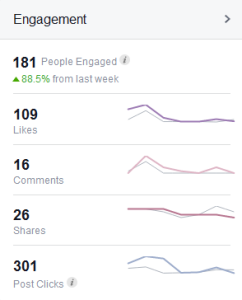 One of the most commonly asked questions marketers hear from their clients is, “How do I know my social media plan is working?” Our answer, “Metrics!” Social media platforms, such as Twitter and Facebook, each have a defined set of metrics to show you just how well your page, posts, and feedback are performing.
One of the most commonly asked questions marketers hear from their clients is, “How do I know my social media plan is working?” Our answer, “Metrics!” Social media platforms, such as Twitter and Facebook, each have a defined set of metrics to show you just how well your page, posts, and feedback are performing.
Facebook has three main metrics that can help you define the overall success of your social media plan. These three are page likes, post reach, and engagement. With all of the recent updates and changes Facebook has been making, it is important to monitor your metrics and see how you may need to adjust.
1. Page Likes: This number is important because you are able to see how many people show interest in your company and its products/services. By monitoring this number your can track what content is drawing people to your page.
2. Post Reach: Post Reach is associated with the number of unique people who have seen one of your posts. Posts can be seen on your page, on a friend’s page who has shared the post, or even an ad. The higher your post reach, the higher your level of visibility.
3. Engagement: Engagement refers to some form of Facebook action a person has made in connection with your content. Engagement includes people clicking, liking, commenting, or sharing your posts. Getting people engaged in your content is important because you can find what content is or is not working and what people have to say about your company.
Twitter, another major player in the social media world, also has its own defined metrics. Like Facebook, Twitter can show your rate of engagement but Twitter can also show you when the best time to send out your tweet. Other Twitter metrics include retweets, number of times your links are being clicked, as well as a daily breakdown of who has followed you or decided to unfollow.
1. Retweets: By keeping track of how many people retweet, or reshare, your posts can help you decide what information your Twitter followers are finding relevant. The more retweets you have, the more people who are seeing your content.
2. Number of times your links are being clicked: Similar to a retweet in that you can see what information your followers find interesting, knowing the number of times your links are being clicked gives you insight into how many people are wanting to see more of your content. While retweets get you more visibility, increased clicked links shows interest.
3. Followers vs. Unfollows: A cool feature of Twitter metrics is its ability to breakdown your activity daily of people who have begun following you as well as the number of people who opted out of following your content. It is important that you do not concentrate on the daily differences because your followers will constantly fluctuate. What is important is to concentrate on any flow patterns that are noticeable. Maybe you tweeted a picture of an event or shared an article that got a lot of engagement from your followers. By seeing what content attracts the attention of your followers is important because you can then replicate more posts like those and increase your followers that much more. On the flip side, if you see any downward trends focus on that content and see how it can be improved.
If reading these metrics seem like Greek to you, don’t worry, your Lab3 Marketing Scientists have them all figured out and can help you create a successful, personalized social media plan.